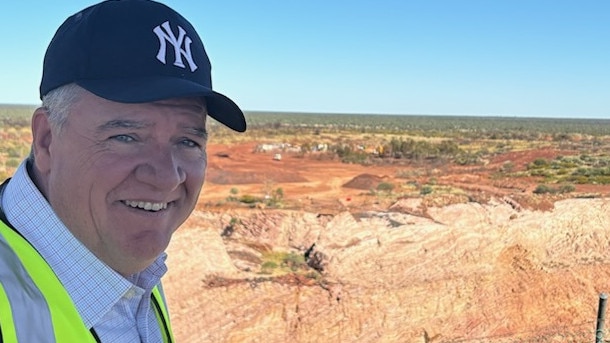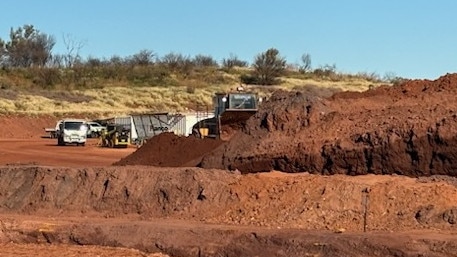Tennant Mining’s plans to revive Territory town’s golden past
A new plan to revive old mines could see a resurgence of a foundation Territory town’s golden history. Read what’s planned.

Northern Territory
Don't miss out on the headlines from Northern Territory. Followed categories will be added to My News.
A fresh chapter could soon be added to the already fascinating story of Nobles Nob gold mine, just east of Tennant Creek.
Standing in front of a mountain on the old Nobles Nob mine site near where Nobles Nob village once was, geologist Michael Hicks recounted the morning in August 1967 when the mine collapsed and the recovery that followed that saw hundreds of tonnes of dirt stacked behind the site as Nobles Nob is eventually transformed to open cut.
“To get back on the ground quickly they ripped (the mine contents) all out and chucked it into a pile,” Michael said, pointing to the hill behind him.
“It looks like a natural hill but it’s not. The natural hill’s up the back there but this whole area here is just the stuff brought up from underground.

“They were mining three-and-a-half kilograms (of gold) a tonne, we’re chasing one-and-a-half grams per tonne. This thing in its heyday was three-and-a-half kilograms a tonne. It was the highest grade gold mine in Australia. At one point I believe 75 per cent of the Territory government’s income came from this mine.”
For the past two years Michael has been senior geologist at Tennant Mining, part of a team trying to spark a rush in the town that farewelled its last gold mine almost 20 years ago.
Last month Tennant Mining began work on a new $98m gold processing plant at Nobles, one of hundred of abandoned mines in the Barkly.
The company wants to initially process the stockpiles and tailings from Nobles' man-made hill from the plant, which will be relocated to Tennant by truck from the Great Australia Mine in Cloncurry.
Tennant Mining hopes the mine will deliver an expected 80 jobs during assembly and up to 160 ongoing when it’s commissioned in the second-half of next year.
The company said it would produce an average of 65,000 ounces of gold annually, if the project succeeds.

Territory Mining bought three of the Barkly’s best producing mines and has a stake in a number of others, but wants the processing plant to also be a hub for other decommissioned mines in the region, many of which closed decades before Giants Reef shut Chariot, the district’s last gold mine, in 2005.
For the past four years privately-owned Tennant Minerals’ management has been capital raising and planning the Barkly’s revival as a gold and copper precinct largely outside the public glare.
That was until Friday when the company, including managing director Peter Main, hosted passengers from an NT government charter flight - including Mining Minister Mark Monaghan and media - to its Nobles Nob site to discuss the company’s plans.
Territory taxpayers have a stake in the project through a $10m loan from the government’s Local Job Fund, which Peter Main said had allowed Tennant Mining to generate an additional $37m investment and a $10m cost overrun facility.

He said at current projections, the loan would be repaid within three years.
“The Local Jobs Fund was a major catalyst for us being able to source commercial funds in what has been a very trying market for junior companies to raise capital,” he said. “That was a major milestone and from our perspective, and certainly from the mining industry in general (and) junior companies, that I haven’t seen done previously.
“Obviously we produced a very economically viable project (and) the Local Jobs Fund gave us the comfort to do that. I can’t overstate the importance of that to us as a company.”
He acknowledged the challenges ahead and multiple failures to revive Barkly mines, but said the supercharged gold price, the company’s strong capital base and its consolidated approach to processing the resource set it apart from previous attempts.
He said launching a mine revival when the gold price was $500 an ounce was more challenging than when the price hovered around $3500.
“That’s a major difference in economic viability,” he said. “The issue I’ve seen in the past is that people have been undercapitalised and we’ve been very mindful of that.

“We’ve made sure our board has been very aggressive in the sense they wouldn’t let us go, and that’s what took us so long. Our board wanted us to take a conservative approach on funding, but the bottom line is very much the gold price differential.
”We’re just going where miners have been before. It’s brownfield, not greenfield and we’re avoiding environmental approval delays because we’re operating on pre-disturbed grounds.”
He acknowledged the project faces challenges ahead of planned production in the second-half of 2025.
“I’m very mindful of the history and the number of companies that haven’t been too successful in this region,” he said.
“They’ve been a lot of failures. The important point is we said to the community when we came here we’re a private company, we don’t arm wave, we just get on and do the job and this is proof of that.
“We’re not over-estimating, we’ve got a lot of work to do. We’re going to build a project over the next 12 months.”
He thanked traditional owners from the Warumungu and Warlmanpa people and the Central Land Council for supporting the revitalisation.
Over recent years Tennant Mining fully acquired Warrego, Juno and Nobles Nob, the region’s three highest production-grade mines and entered a joint venture with explorer Emmerson Resources on a 6 per cent royalty in other Barkly mines including Chariot underground, Malbec West, El Dorado, Golden Kangaroo, Black Snake and Mauretania.
“We consolidated the field … to make sure we’ve got a significant ground position. Of all the mines that were ever active big and small, we’ve probably got control of about 80 per cent.
“We took a deliberate decision that the only way, and I might get slapped by a few people, that the only way to make this field work is to consolidate it … and that’s what we’ve done and then we can build an economic project.
“We’re not a Normanby by any means. I’m not going to kid anyone, and we’re not the panacea of all the problems here, but we’re going to contribute and we’re going to work closely with our community and our stakeholders the government included to deliver that.”
He said Territory Mining would look to employ as many Barkly and Territory workers as possible without “cannibalising” local workforces and was targeting 16 per cent indigenous employment and 25 per cent local employment.
The company bought the 85-room El Dorado hotel in Tennant Creek for worker accommodation and spent $1.1m in upgrades so far with 70 per cent local input and crews from local company Phillips Earthworks Contractors is preparing the pad for the processing plant.
About 20 workers are currently on site.
It has done business with about 145 local services to date of which 64 per cent of those were in the Barkly.
“If you look at mining most of us build camps,” Mr Pain said. “We’re 14km from the town and we wanted to integrate into the community.
He listed a number of key project milestones including an annual $65-70m project spend, a 54 per cent local capital spend to date — although that is expected to drop — and minimum annual royalties of $8m a year to about $70m over the projected eight year first stage.
If a second phase extends the project to 15 years and beyond, production would increase to 100,000 ounces, which could add up to 40 per cent to the royalty payment. About $40m dollars has been spent so far with $53m remaining during construction phase.
“If you look at our project capital cost, it’s going to cost us $48m,” he said. “We’ve got a contingency of $5m, then we’ve got surplus capital of another $4m and a cash surplus of $7-8m.
“A $48m spend, we’ve locked in all our costs on $26m of it, so we’re only exposed on $22m on cost increases.”
Mining would be a standard gold process “used everywhere else around the country”.
Minister Monaghan backed the project to extend beyond its initial eight-year phase.
“I’m very confident the projections that they’ll meet the 15-year period and we’re looking at all our calculations based on that,” he said.
“There is a lot of opportunities because there’s a lot of gold in these hills around here and there’s a lot increased exploration happening.
“The other thing I’m really confident about is because once we get processing plant close on site in Tennant Creek, that actually makes it a lot cheaper for other people to work with this company to ensure there projects are more financially viable.
“I’m hoping this region will move off the back of the first substantial mining opening up here.”
More Coverage
Originally published as Tennant Mining’s plans to revive Territory town’s golden past





